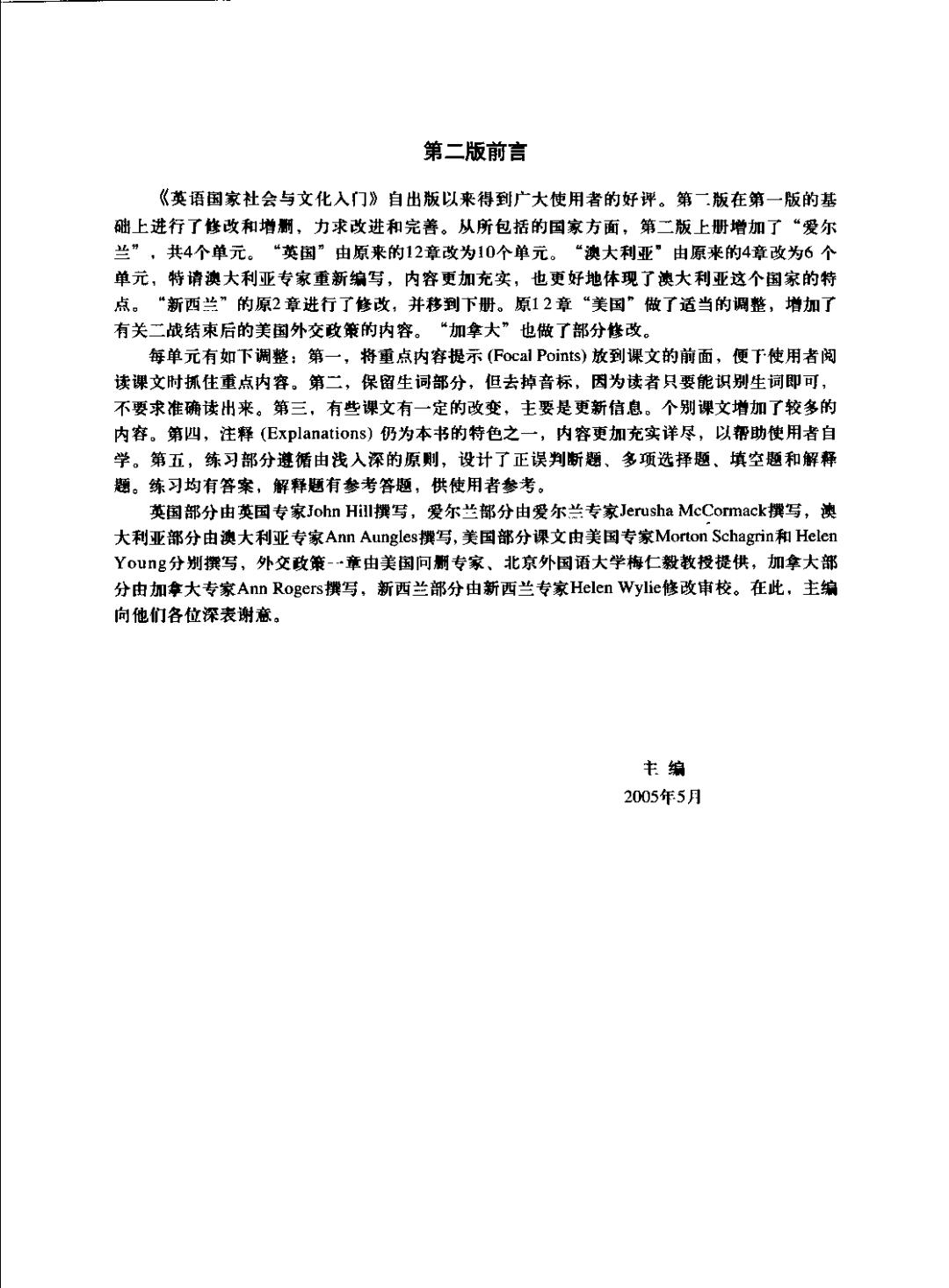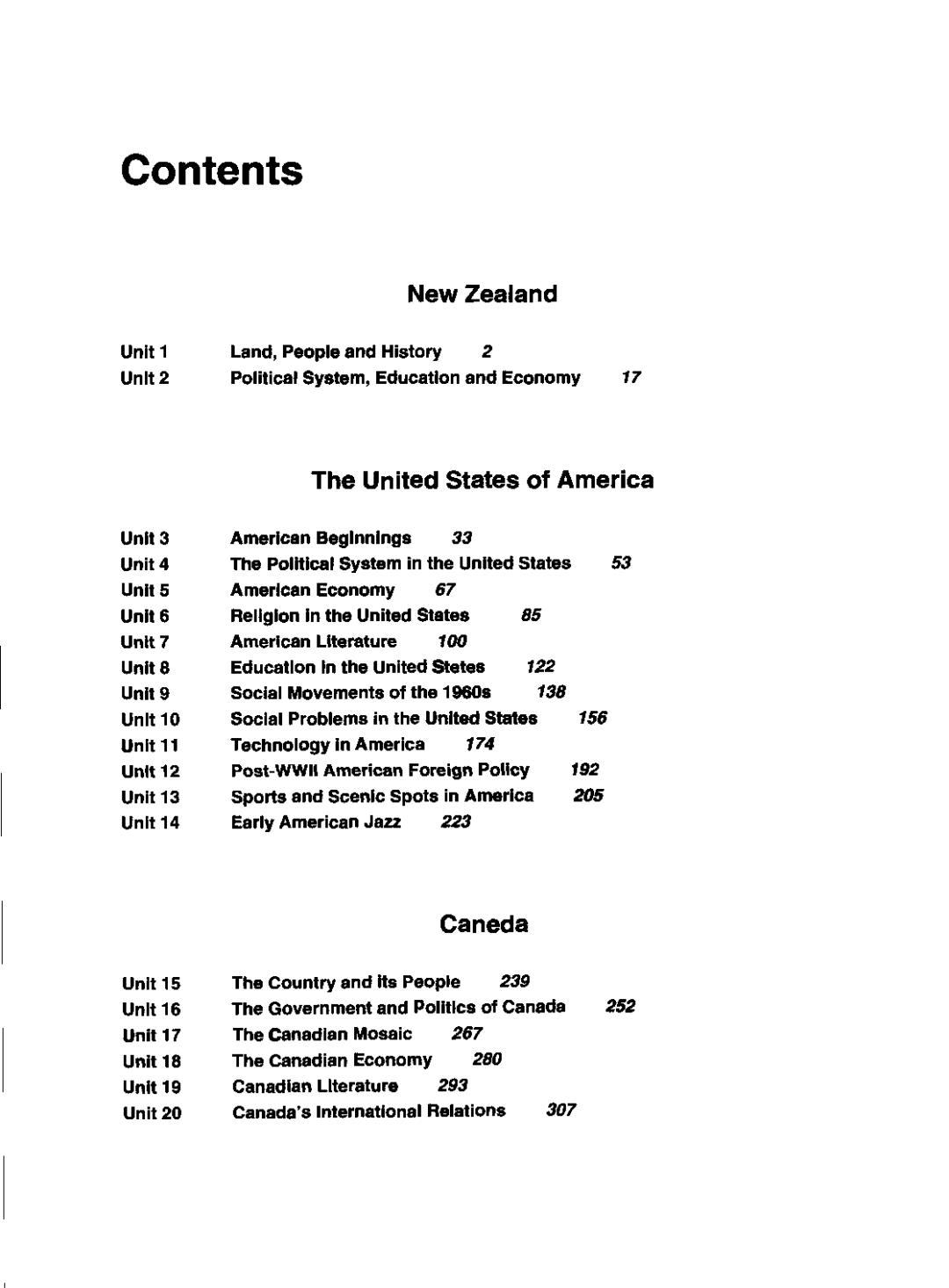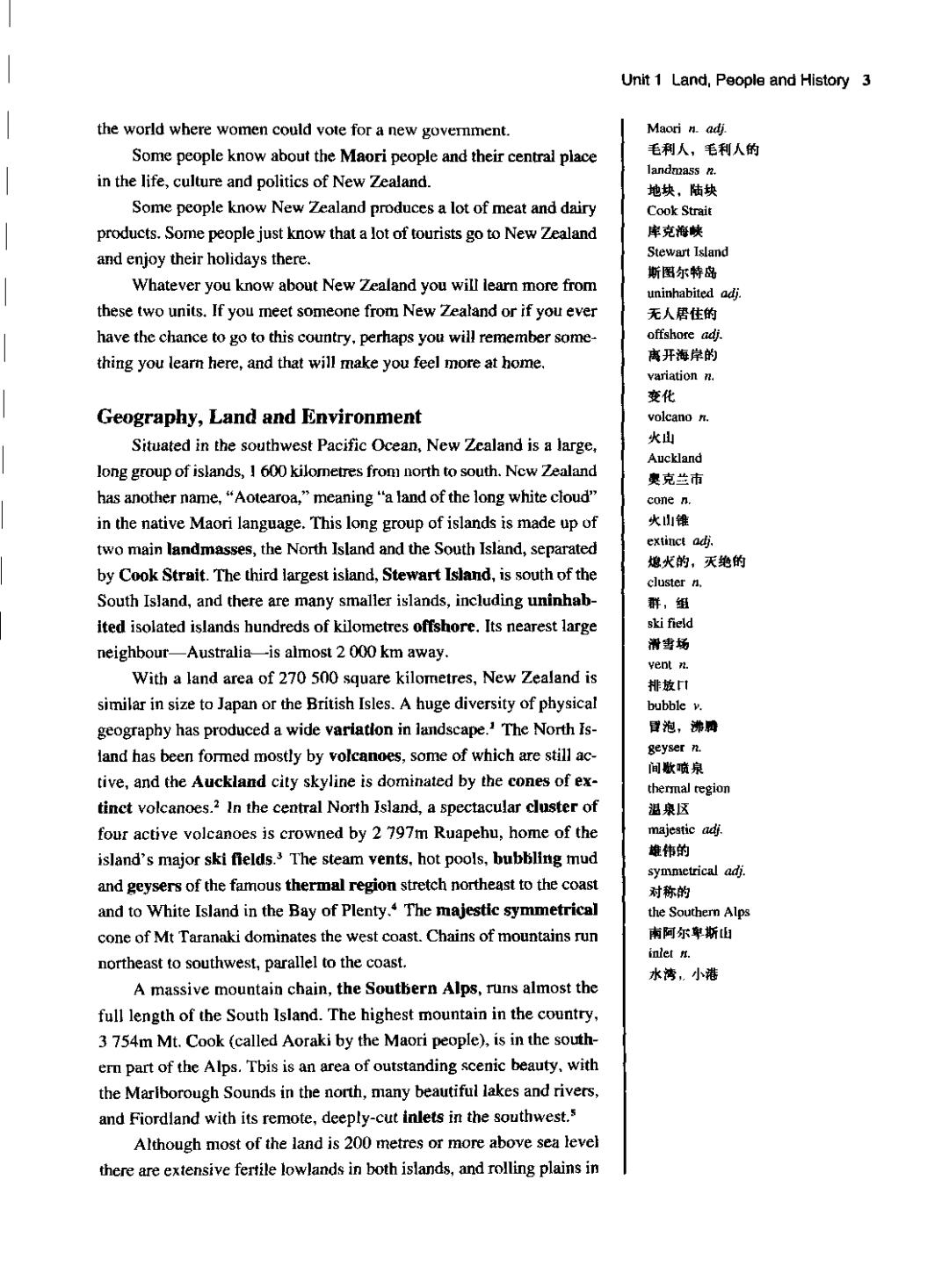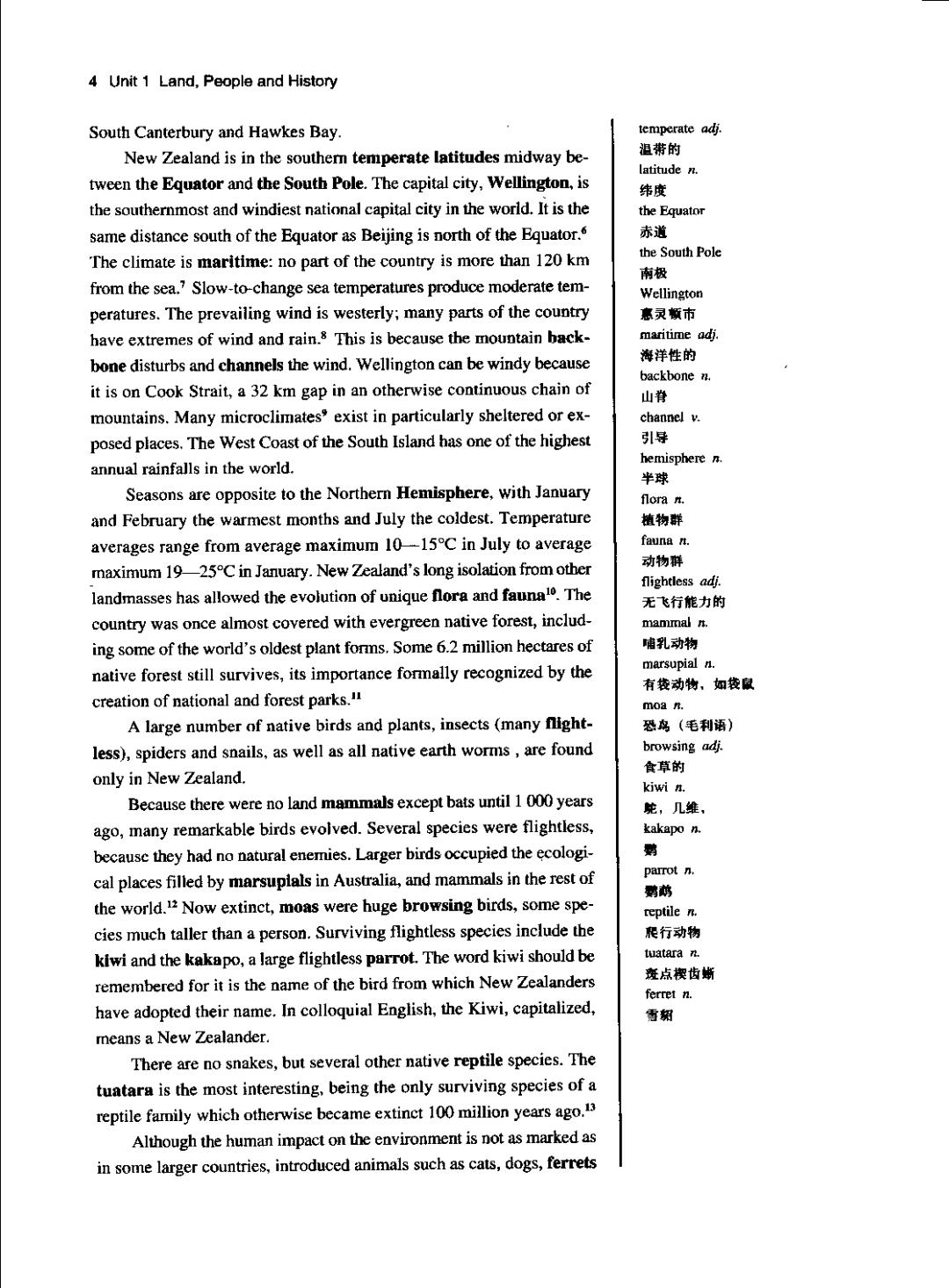
第二版前言 《英语国家社会与文化入门》自出版以来得到广大使用者的好评。第一版在第一版的基 础上进行了修改和增翻,力求改进和完善。从所包括的国家方面,第二版上册增加了“爱尔 兰”,共4个单元。“英国”由原来的12章改为10个单元。“澳大利亚”由原来的4章改为6个 单元,特请澳大利亚专家重新编写,内容更加充实,也更好地体现了澳大利亚这个国家的特 点。“新西兰”的原2章进行了修改,并移到下册。原12章“美国”做了适当的调整,增加了 有关二战结束后的美国外交改策的内容。“加拿大”也做了部分镂改。 每单元有如下调整:第一,将重点内容提示(Focal Points)放到课文的前面,便于使用者阅 读课文时抓住重点内容。第二,保留生词部分,但去掉音标,因为读者只要能识别生词即可, 不要求准确读州来。第三,有些课文有一定的改变,主要是更新信息。个别课文增加了较多的 内容。第四,注释(Explanations)仍为本书的特色之一,内容更加充实详尽,以帮助使用者自 学。第五,练习部分遵循由浅入深的原则,设计了正误判断题、多项选择题、填空题和解释 题。练习均有答案,解释题有参考答题,供使用者参考。 英国部分由英国专家John Hill撰写,爱尔兰部分由爱尔兰专家Jerusha McCormack撰写,澳 大利亚部分由澳大利亚专家Ann Aungles撰写,美国部分课文由美国专家Morton Schagrin和Helen Yo心ng分别撰写,外交改策-一章由美国问删专家、北京外国语大学梅仁毅教授提供,加拿大部 分由加拿大专家Ann Rogers撰写,新西兰部分由新西兰专家Helen Wylie修改审校。在此,主编 向他们各位深表谢意。 丰编 2005年5月

Contents New Zealand Unit 1 Land, People and History 2 Unlt 2 Political System, Education and Economy 17 The United States of America Unit 3 American Beglnnings 33 Unit 4 The Political System in the United States 53 Unit 5 Amerlcan Economy 67 Unit 6 Religion in the United States 85 Unit 7 American Literature 100 Unit 8 Educatlon in the United Stetes 122 Unit 9 Social Movements of the 1960s 138 Unlt 10 Social Problems in the United States 156 Unit 11 Technology in America 174 Unit 12 Post-WWll American Foreign Policy 192 Unit 13 Sports and Scenic Spots in America 205 Unit 14 Early American Jazz 223 Caneda Unit 15 The Country and its People 239 Unlt 16 The Government and Politlcs of Canada 252 Unit 17 The Canadian Mosaic 267 Unit 18 The Canadian Economy 280 Unit 19 Canadian Llterature 293 Unit 20 Canada's International Relations 307

Unit 1 LAND,PEOPLE AND HISTORY Go over the following focal points before reading the text: geography:Narth Island and South Island weather wildlifeunique flora and fauna environmental responsibility Maori society Maoritanga Pacific Island people race relations history:first settlers of the Islands relationship between Maori and Pakeha Text New Zealand is a special country in many ways.It is a small coun- geological adj. try with a small population,a long way from the large powerful coun- 地质学的 tries,but many people know about New Zealand. Maybe when someone mentions New Zealand you think of a clean, green image:fresh air;clean rivers,lakes and sea;clean food;green trees and mountains and blue skies.Some people are aware of New Zealand because it has an interesting geological history.The islands of New Zealand have been separated from other land for millions of years, and they have unique plants,birds and insects. Some people know about New Zealand because the Government and people speak out against nuclear weapons and nuclear power.Some people may know that in 1893 New Zealand became the first country in

Unit 1 Land,People and History 3 the world where women could vote for a new goverment. Maori n.adj. Some people know about the Maori people and their central place 毛利人,毛利人的 landmass n. in the life,culture and politics of New Zealand. 地块,陆块 Some people know New Zealand produces a lot of meat and dairy Cook Strait products.Some people just know that a lot of tourists go to New Zealand 库克海峡 and enjoy their holidays there. Stewart Island 斯图尔特岛 Whatever you know about New Zealand you will learn more from uninhabited adj. these two units.If you meet someone from New Zealand or if you ever 无人居住的 have the chance to go to this country,perhaps you will remember some- offshore adj thing you learn here,and that will make you feel more at home. 离开海岸的 variation n. 变化 Geography,Land and Environment volcano n. Situated in the southwest Pacific Ocean,New Zealand is a large, 火山 Auckland long group of islands,600 kilometres from north to south.Ncw Zealand 臭克兰市 has another name,"Aotearoa,"meaning"a land of the long white cloud" cone n. in the native Maori language.This long group of islands is made up of 火山锥 two main landmasses,the North Island and the South Island,separated extinct adi. 熄火的,灭绝的 by Cook Strait.The third largest island,Stewart Island,is south of the cluster n. South Island,and there are many smaller islands,including uninhab- 群,组 ited isolated islands hundreds of kilometres offshore.Its nearest large ski field neighbour-Australia-is almost 2 000 km away. 滑雪场 yent n. With a land area of 270 500 square kilometres,New Zealand is 排放F口 similar in size to Japan or the British Isles.A huge diversity of physical bubble v. geography has produced a wide variatlon in landscape.1 The North Is- 置泡,沸烟 land has been formed mostly by volcanoes,some of which are still ac- geyser n. 间歇喷泉 tive,and the Auckland city skyline is dominated by the cones of ex- thermal region tinet volcanoes.2 In the central North Island,a spectacular cluster of 温泉区 four active volcanoes is crowned by 2 797m Ruapehu,home of the majestic adj. island's major ski fields.3 The steam vents,hot pools,bubbling mud 雄伟的 symmetrical adj. and geysers of the famous thermal region stretch northeast to the coast 对称的 and to White Island in the Bay of Plenty.The majestic symmetrical the Southern Alps cone of Mt Taranaki dominates the west coast.Chains of mountains run 南阿尔单斯山 northeast to southwest,parallel to the coast. iniet 水湾,小港 A massive mountain chain,the Southern Alps,runs almost the full length of the South Island.The highest mountain in the country, 3 754m Mt.Cook (called Aoraki by the Maori people),is in the south- ern part of the Alps.Tbis is an area of outstanding scenic beauty,with the Marlborough Sounds in the north,many beautiful lakes and rivers, and Fiordland with its remote,deeply-cut inlets in the southwest.s Although most of the land is 200 metres or more above sea level there are extensive fertile lowlands in both islands,and rolling plains in

4 Unit 1 Land,People and History South Canterbury and Hawkes Bay. temperate adj. New Zealand is in the souther temperate latitudes midway be- 温带的 latitude n. tween the Equator and the South Pole.The capital city,Wellington,is 纬度 the southernmost and windiest national capital city in the world.It is the the Equator same distance south of the Equator as Beijing is north of the Equator.s 赤道 The climate is maritime:no part of the country is more than 120 km the South Pole 南极 from the sea.?Slow-to-change sea temperatures produce moderate tem- Wellington peratures.The prevailing wind is westerly;many parts of the country 惠灵顺市 have extremes of wind and rain.8 This is because the mountain back- maritime adj. 海洋性的 bone disturbs and channels the wind.Wellington can be windy because backbone n. it is on Cook Strait,a 32 km gap in an otherwise continuous chain of 山脊 mountains.Many microclimates exist in particularly sheltered or ex- channel v. posed places.The West Coast of the South Island has one of the highest 引导 annual rainfalls in the world. hemisphere n 半球 Seasons are opposite to the Northern Hemisphere,with January flora n. and February the warmest months and July the coldest.Temperature 植物群 averages range from average maximum 10-15C in July to average fauna n. maximum 19-25C in January.New Zealand's long isolation from other 动物群 flightless adj. landmasses has allowed the evolution of unique flora and faunal.The 无飞行能力的 country was once almost covered with evergreen native forest,includ- mammal n. ing some of the world's oldest plant forms.Some 6.2 million hectares of 哺乳动物 native forest still survives,its importance formally recognized by the marsupial n. 有袋动物、如袋酿 creation of national and forest parks. moa n. A large number of native birds and plants,insects(many flight- 恐鸟(毛利语) less),spiders and snails,as well as all native earth worms,are found browsing adj. 食草的 only in New Zealand. kiwi n. Because there were no land mammals except bats until 1 000 years 蛇,几维, ago,many remarkable birds evolved.Several species were flightless, kakapo n. because they had no natural enemies.Larger birds occupied the ecologi- 鹦 cal places filled by marsupials in Australia,and mammals in the rest of parrot n. 剪鹉 the world.12 Now extinct,moas were huge browsing birds,some spe- reptile n. cies much taller than a person.Surviving flightless species include the 爬行动物 kiwi and the kakapo,a large flightless parrot.The word kiwi should be tuatara n. remembered for it is the name of the bird from which New Zealanders 斑点楔齿蜥 ferret n. have adopted their name.In colloquial English,the Kiwi,capitalized, 雪期 means a New Zealander. There are no snakes,but several other native reptile species.The tuatara is the most interesting,being the only surviving species of a reptile family which otherwise became extinct 100 million years ago.1 Although the human impact on the environment is not as marked as in some larger countries,introduced animals such as cats,dogs,ferrets